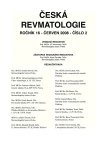-
Medical journals
- Career
Cohort study of ankylosing spondylitis in the central Europe region: disease activity, ways of treatment and possibilities of biological therapy application
Authors: K. Pavelka
Authors‘ workplace: Revmatologický ústav, Praha
Published in: Čes. Revmatol., 16, 2008, No. 2, p. 64-69.
Category: Original Papers
Overview
Ankylosing spondylitis (AS) is an inflammatory disease from the group of spondylarthropathies, which manifests sacroiliitis, spondylitis, enthesitis, sometimes peripheral arthritis and extra-articular symptoms, as well. It has a significant influence on patients‘ morbidity and in practice, it is often recognized too late, its course is insufficiently monitored and no efficient therapy is usually administred. The aim of the study was to obtain demographic and clinical data on the course of AS in clinical practice in the Central and Eastern Europe region. Furthermore, the frequency of patients indicated to anti-TNF therapy was investigated. The study dealt with methodological aspect, as well, to which extent the patient’s subjective statement on the level of his ailment (BASDAI) correlates to the specialist’s opinion on the suitability of anti-TNF therapy indication. The study was based on a questionnaire filled out by an erudite rheumatologist. In addition to demographic indicators, anamnestic data on comorbidities, previous and present therapy, disease activity and the quality of life (BASDAI, BASFI, ASQol) have been monitored. The patients with AS, who had not yet been treated with anti-TNF therapy, were included to the study.
A total of 1650 patients were included in the study, thereof 1506 were evaluated. Patients from 7 countries were concerned (Austria, Czech Republic, Slovakia, Poland, Hungary, Romania, Slovenia). A total of 281 rheumatologists included the patients (3–5 each). 913 patients (61 %) were marked by medicine doctors as candidates for anti-TNF therapy. While comparing candidates and non-candidates, it was found out that candidates for anti-TNF therapy were younger, they had higher BASDAI, BASFI, ASQol, more frequent enthesopathies, involvement of hips and higher erythrocyte sedimentation rate and CRP. Nevertheless, 38 % of these candidates for anti-TNF therapy met the ASAS criteria for anti-TNF therapy and only 16 % of non-candidates did. So it seems that the BASDAI evaluation is very important for anti-TNF therapy indication, indeed, but the specialist’s evaluation is no less important, as well.Key words:
ankylosing spondylitides, anti-TNF therapy
Sources
1. Braun J, Sieper J. Ankylosing spondylitis. Lancet 2007; 369 : 1379–90.
2. Braun J, Bollow M, Remlinger G, Eggens U, et al. Prevalence of spondylarthropathies in HLA-B27 positive and negative blood donors. Arthritis Rheum 1998; 41 : 58–67.
3. Hánová P, Pavelka K, Dostál C, et al. Epidemiology of rheumatoid arthritis, juvenile idiopathic arthritis and gout in too regimens of the Czech Republic in a descriptive population – based survey in 2002–2003. Clin Exp Rheum 2006; 24 : 499–507.
4. Pavelka K, Forejtová Š. Časná diagnostika ankylozující spondylitidy. Postgraduální medicína 2007; 9 : 180–4.
5. Feldtkeller E, Khan MA, van der Heijde D, et al. Age at disease onset and diagnosis delay in HLA-B27 negative vs. positive patients with ankylosing spondylitis. Rheumatol Int 2003; 23 : 61–6.
6. Ward MM. Quality of life in patients with nakylosing spondylitis: a survey of 175 patients. Arthritis Care Res 1999; 12 : 247–55.
7. Braun J, Pham T, Sieper J, Davis J, et al. ASAS Working Group. International ASAS consensus statement for the use of anti-tumour necrosis factor agents in patients with ankylosing spondylitis. Ann Rheum Dis 2003; 62 : 817–24.
8. Zochling J, van der Heijde D, Burgos-Vargas R, et al. ASAS/EULAR recommendations for the management of ankylosing spondylitis. Ann Rheum Dis 2006; 65 : 442–52.
9. Braun J, Brandt J, Listing J, et al. Treatment of active ankylosing spondylitis with infliximab: a randomised controlled multicentre trial. Lancet 2002;359 : 1187–93.
10. Davis JC Jr, van der Heijde D, Braun J, et al. Recombinant human tumor necrosis factor receptor (etanercept) for treating ankylosing spondylitis: a randomized, controlled trial. Arthritis Rheum 2003; 48 : 3230–6.
11. Sieper J, Rudwaleit M, Braun J. Adalimumab for the treatment of ankylosing spondylitis. Expert Opin Pharmacother 2007; 8 : 831–8.
12. Rudwaleit M., Clandepierre P, Wordworths, et al. Adalimumab is effective and well – tolerated in treating AS in real-life Clinical Practice. The RHAPSODY trial. Arthritis Rheum 2007; 56: S472.
13. Pavelka K, Štolfa J, Vencovský J. Doplněk standardních léčebných postupů u ankylozující spondylitidy. Čes Revmatol 2004; 12 : 30–35.
14. Pham T, Landewe R, van der Linden S, et al. An international study on starting tumour necrosis factor-blocking agents in ankylosing spondylitis. Ann Rheum Dis 2006; 65 : 1620–5.
15. Ebner W, Palotai T, Codreanu C, et al. A cross-sectional survey of treatment patterns, disease activity and quality of life of patients with ankylosing spondylitis in central and eastern Europe. Clin Exp Rheum (Submitted).
Labels
Dermatology & STDs Paediatric rheumatology Rheumatology
Article was published inCzech Rheumatology

2008 Issue 2-
All articles in this issue
- Cohort study of ankylosing spondylitis in the central Europe region: disease activity, ways of treatment and possibilities of biological therapy application
- Treatment of wrist extensors
- The results of volumetry measurement of brain pathological lesions in patients with systemic lupus erythematosus
- Ways of protection of reproductive functions of women and men undergoing treatment with cytotoxic drugs
- Scoring systems for evaluation of radiographic progression of rheumatoid arthritis
- Wegener’s granulomatosis with thrombotic thrombocytopenic purpura – neurologic manifestations
- Czech Rheumatology
- Journal archive
- Current issue
- Online only
- About the journal
Most read in this issue- Treatment of wrist extensors
- Wegener’s granulomatosis with thrombotic thrombocytopenic purpura – neurologic manifestations
- Scoring systems for evaluation of radiographic progression of rheumatoid arthritis
- The results of volumetry measurement of brain pathological lesions in patients with systemic lupus erythematosus
Login#ADS_BOTTOM_SCRIPTS#Forgotten passwordEnter the email address that you registered with. We will send you instructions on how to set a new password.
- Career

